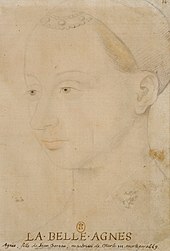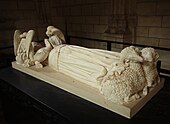Agnes Sorel

Agnès Sorel (* around 1422 at Fromenteau Castle ; † February 9, 1450 in Anneville-sur-Seine ) was the first official mistress of the French King Charles VII.
Life
Agnès Sorel was the daughter of Jean Soreau, a soldier from low nobility, and Catherine de Maignelais. She was first lady-in-waiting of Isabella , Duchess of Lorraine and wife of King René of Naples . In contemporary sources, Agnès Sorel is described as an exceptionally beautiful and extremely intelligent young woman.
During a visit to his brother-in-law, the King of France met the twenty-year-old blonde beauty for the first time. In the entourage of Isabella of Lorraine, Duchess of Anjou, she came to the French court during the Hundred Years War in 1431 as their maid of honor, where a love affair between Karl and Agnès developed in the following years. The king finally appointed his mistress as the lady of honor of his wife Marie d'Anjou , and gave her Beauté-sur-Marne castle near Paris in 1448, along with various other castles and country estates ( Issoudun , Bois-Trousseau, Roquecezière in the Rouergue and Vernon-sur-Seine ) and occupied influential posts at the French court with members of the Sorel family. She got the nickname "Dame de Beauté", which was derived from the name of the castle Beauté-sur-Marne. As her private residence, she also received the Castle of Loches, where Charles, as Dauphin , had received Joan of Arc in June 1429 after the successful siege of Orléans and had been convinced of the coronation in Reims.
Since 1444 Agnès Sorel was the official lover of Charles VII and thus the first official mistress at the French royal court. She gave Karl four daughters, one of whom died as an infant. As an influential lady-in-waiting at the French royal court and mistress of King Charles VII of France, Agnès Sorel introduced the fashion of the uncovered breast . In 1445 she retired to Loches and stayed there for five years. In 1450, when she was pregnant with the youngest child, Charles VII visited her in a camp during a campaign against the English in Jumièges , a town in Normandy .

Shortly after the birth of her fourth child, Agnès Sorel fell seriously ill. Your contemporaries referred to this disease as "flux de ventre" (stomach flow). Because of her early death and numerous enemies, rumors circulated that Agnès Sorel had been poisoned. Agnès Sorel died on February 9 or 11, 1450 at six o'clock in the afternoon at the age of 28 in Masnal-la-Belle Castle in the French community of Anneville-sur-Seine. "How disgusting, smelly and fragile we are", are said to have been her last words on her deathbed. The body was opened and the corpse was transferred to Loches after the heart had been removed . Her heart was buried in the Abbey of Jumièges, to whom she had donated a lot of money. Her body was buried in the Notre-Dame collegiate church in Loches (Saint Ours church). After the death of Agnès Sorel, Antoinette de Maignelais , a first cousin of Agnès Sorel, became the king's new mistress.
Charles's son, who later became King Louis XI. , haunted his father's lover all his life with his hatred. He is said to have slapped his father's mistress once in public. After her sudden death, Ludwig was immediately suspected of having murdered Agnès Sorel or of having given the order to murder her. However, this thesis could not be proven. It is still unclear whether she was poisoned or just died of medical malpractice.

Later criminal investigations
In 2004 Agnès Sorel's grave in Loches was opened and investigated for a criminal investigation. The paleopathologist Philippe Charlier showed that Sorel was seven months pregnant and had worms. The cause of death was diagnosed as mercury poisoning , presumably caused by a treatment for birth disorders and worms that was customary at the time. Since the safe doses were known at the time, it is possible that a lethal dose of mercury was deliberately administered to Sorel.
Using the skull found in the grave, experts from the French gendarmerie were able to reconstruct the face of Agnès Sorel. After completing the investigation, her bones were reburied on April 2, 2005 in the presence of representatives of the French nobility in the collegiate church of Loches.
progeny
-
Marie (* 1444; † 1473), who was married to Olivier de Coëtivy , Lord of Taillebourg ( House of Coëtivy ) on October 28, 1458 .
- Charles ⚭ 1511 Jeanne d'Orléans, († 1520), daughter of Jean d'Orléans, comte d'Angoulême et de Périgord and Marguerite de Rohan
- Adelice, ⚭ Henri, Seigneur de Penmarc'h
- Catherine, ⚭ Antoine de Chourses, Seigneur de Magné et d'Échiré
- Marguerite, ⚭ François de Pons, Comte de Montfort
- Gilette, ⚭ I Jacques d'Estouteville, † before 1510, son of Robert d'Estouteville, Seigneur de Beyne, and Ambroise de Loré, ⚭ II Antoine I. de Luxembourg, Comte de Brienne, † 1519, son of Louis de Luxembourg, Comte de Saint-Pol, Connétable of France (House Luxemburg-Ligny), and Jeanne de Bar
- Charlotte (* approx. 1446; † 1477), who was married to Jacques de Brézé ( House of Brézé ) on 1462 , who murdered her with the sword in the arms of her lover.
-
Jeanne , who was on December 25, 1461 by Louis XI. was married to Antoine de Bueil ( Bueil House ).
- Jacques de Bueil, † 1513, Count of Sancerre
- Renée; ⚭ Johann von Bruges , Mr. von Gruuthuse
- Daughter (* February 3, 1450, † February 3, 1450) was a premature baby who was born after six months of pregnancy and died a few hours after birth
Her descendants include the current Duke of Orléans , Prince Jacques of France and Prince Charles Emmanuel of Bourbon-Parma .
literature
- Père Anselme : Histoire généalogique de la maison royale de la France et des grands officiers de la couronne , Volume VII (1733) pp. 843-848
- Eleanor Herman: Love in the Shadow of the Crown. The story of the royal mistresses . Fischer, Frankfurt am Main 2004, ISBN 3-596-15987-3 .
- Christine Juliane Henzler: The wives of Charles VII and Louis XI: Their role and position at the French royal court (1422–1483) . (= Archive for Cultural History. Supplements to the Archive for Cultural History . Volume 71). Böhlau, Cologne 2012, ISBN 978-3-412-20879-0 .
Web links
- Collection of materials on Agnès Sorel on Mittelalter-genealogie.de
- Article on the examination of the bones of Agnès Sorel (French)
- (French) ( Memento from August 26, 2010 in the Internet Archive )
- 560 years ago: Agnès Sorel dies in Anneville-sur-Seine. Mistress of Beauty , WDR 2 due date February 9, 2010
Individual evidence
- ↑ René König : Revealing Veils. In: Die Zeit № 1/1963.
- ↑ The mysterious death of the mistress. dpa message, Die Welt , April 4, 2005.
| personal data | |
|---|---|
| SURNAME | Sorel, Agnes |
| ALTERNATIVE NAMES | Dame de Beauté |
| BRIEF DESCRIPTION | French mistress of King Charles VII of France |
| DATE OF BIRTH | around 1410 or 1422 |
| PLACE OF BIRTH | Fromenteau Castle |
| DATE OF DEATH | February 9, 1450 or February 11, 1450 |
| Place of death | Anneville-sur-Seine |

